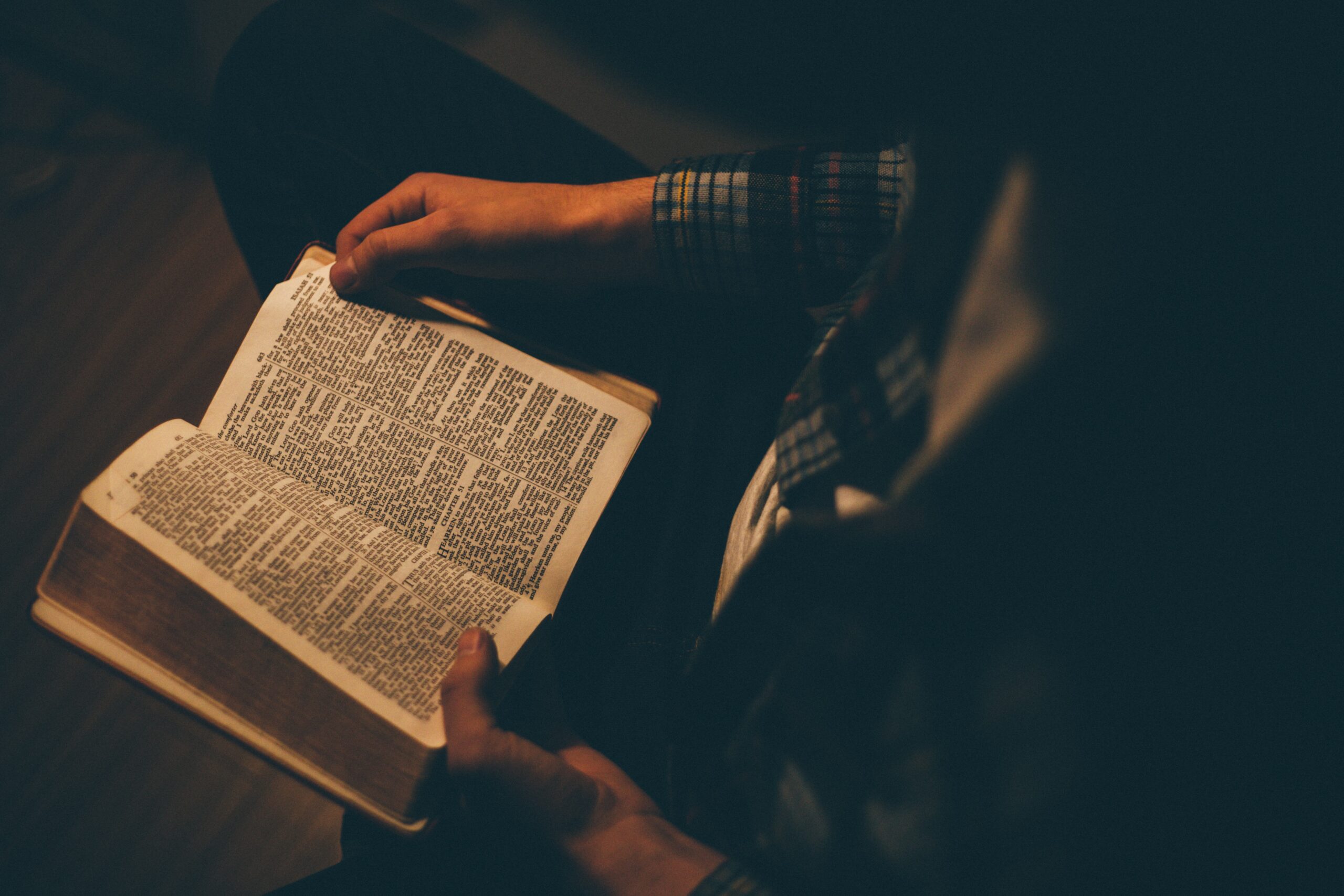How should an LGBTQ person approach the Bible, especially when some of its texts have been used against them? In what follows, I will try to answer this question by demonstrating four steps to reading Scripture and by highlighting Old Testament traditions that might inspire LGBTQ communities.
1. Read as you are and from where you are.
2. Lean into what resonates with you.
3. Pray with Scripture even if you critique it.
4. Study with liberation in mind but recognize that not all texts are liberative.
To be fair, these are recommendations that I would give to anyone venturing into biblical study. Critically and prayerfully reading Scripture can be intellectually and spiritually enriching, but it is complicated and potentially damaging, especially for LGBTQ people.
The four steps listed above are an adapted Lectio Divina (“Sacred Reading”: read—meditate—pray—contemplate). These modifications offer a way to read Scripture thoughtfully, recognizing the importance of how we bring our whole selves to encounter God in its texts. The purpose of these steps is not to reach one definitive interpretation. Rather, this approach offers a way to engage Scripture, especially texts that can be difficult and problematic.
In this reflection, I will focus on portions of Genesis 19:1-38, the story of Sodom and Gomorrah, a potential “clobber text.” I recommend you read it in full, and I will draw attention to interpretive possibilities that might inspire rather than clobber. I will also recommend a few other Old Testament texts that might be more inspiring, especially for LGBTQ readers.
1. Read as you are and from where you are
I am an African-American Catholic woman, daughter, biblical scholar and ally to LGBTQ people. I bring these aspects of myself and more with me when I study and pray with Scripture. When I read Genesis 19, I am disturbed by its content and by the ways it has done harm to LGBTQ people. I am conscious of not wanting to promote harmful interpretations. It is important for readers to feel empowered and inspired to read in ways that will not promote hate.
2. Lean into what resonates with you
Not much in Genesis 19 resonates with me, and it is okay and important to say so. Not all texts are instructive or inspirational, even if we might want them to be. We can be selective when choosing texts for theological reflection. The Lectionary is an example of such a selection process, and it is notable that most “clobber texts” are not proclaimed from the pulpit.
Reading Genesis 19 as a statement against homosexuality is limited and ill-considered.
In Genesis 19, what resonates most with me is Lot’s hospitality. When Lot encounters the men/angels, he regards them as aliens to the land, offering them respect, food, care and shelter (Gen. 19:1-2). He treats them with dignity by washing their feet, which is a gesture of care and providing protection when their lives are threatened.
Readers who are from LGBTQ communities might draw inspiration from the way that Lot interacts with the men/angels and the ways they rally together and protect themselves when under attack.
3. Pray with Scripture, even if you critique it
If I were praying with Genesis 19, I would offer thanks to God for giving me the time, space and ability to reflect on the text. I would focus on those first two verses and think of ways that I might be more hospitable, especially to groups who are on the margins of society.
I would also pray with the problematic elements and interpretations. For instance, because the cities of Sodom and Gomorrah are depicted as wicked and because the men of the cities are criticized for their actions, Genesis 19 has been interpreted as biblical evidence against homosexuality, hence its “clobber” status.
The men are described saying, “Where are the men who came to your house tonight? Bring them out to us that we may have sexual relations with them” (Gen. 19:5b). Lot characterizes their demand as wicked and instead offers his virgin daughters to the would-be rapists (Gen. 19:7-8), as presumably this is a better option from his perspective.
Reading Genesis 19 as a statement against homosexuality is limited and ill-considered, as it fails to look at the larger literary context, which is overly concerned about hospitality and navigating relationships with people outside of one’s community. On multiple occasions, Abraham, Sarah and Lot deal with the challenges and vulnerabilities associated with being resident aliens (cf. Gen. 12:10-20; 14:1-16; 20:1-18; 21:22-34; 23:1-20). These themes offer a more informed and less harmful way of interpreting Genesis 19.
Not all texts are instructive or inspirational, even if we might want them to be. We can be selective when choosing texts for theological reflection.
Knowing that this text has been and continues to be read in harmful ways, I would recommend that readers, especially LGBTQ readers, to pray for those all who have been injured by damaging interpretations of Genesis 19 and pray for the courage to work to protect and empower LGBTQ communities.
4. Study with liberation in mind, but recognize that not all texts are liberative
When I read Genesis 19 for liberation, I read with the women of Sodom and Gomorrah and with Lot’s daughters and wife. It is these nameless characters on the margins (or even missing from the narrative) who catch my eye.
For example, the women of Sodom and Gomorrah are not explicitly condemned, but they suffer the same fate as the men of the city. I take this as an example of how people on the margins can bear the brunt of suffering or experience hardships that are not their own creation. A liberative reading might be to use the text as a reminder to think from the experiences of those on the peripheries, and work to promote justice for them.
Another liberative reading would be to draw attention to Lot’s willingness to put his daughters in harm’s way for the sake of his visitors. On the one hand, Lot’s hospitality and protection of the angels could be admirable. Yet, at the same time, by offering his daughters, Lot fails to protect these young women. The daughters receive “justice” at the end of the narrative when they violate their father, giving him alcohol and raping him in order to continue the family line.
Although we are reading Scripture, we should not feel compelled to justify any of the corruptions within it, nor the corrupt interpretations of it.
But a liberative reading of the rape of Lot should not be attempted, and an attempt to rationalize the daughters’ actions could do harm to readers, especially victims and survivors of sexual assault.
Although we are reading Scripture, we should not feel compelled to justify any of the corruptions within it, nor the corrupt interpretations of it. It might be worthwhile to read the chapter as a literary creation whose purpose is not to speak on homosexuality at all, despite the insistence of some narrow-minded interpreters.
Genesis 19 offers a glimpse at how people, especially scribal elites in ancient Israel, thought about themselves vis-à-vis their neighbors. The narrative of Lot’s daughters raping their father, for instance, could serve as a corrupt origin story for Israel’s cousin-neighbors, the Moabites and Ammonites, who are frequently enemies of the Israelites.
Likewise, the destruction of the Transjordanian cities of Sodom and Gomorrah could create and heighten an “us vs. them” attitude between communities living east or west of the Jordan River.
Having explored Genesis 19 with the adapted Lectio Divina in mind, what should we conclude? LGBTQ readers should recognize the power and perspective that they bring to biblical interpretation. Understand and embrace the ways that social location, lived experiences, relationships and faith commitments influence how you arrive at a text and what you draw from it. Another step forward is to recognize the richness of tradition and explore other texts that are more affirming and encouraging.
Reading more affirming Old Testament texts
The relationship between David and Jonathan is an example of a close, loving relationship between two men that is affirmed in Scripture. On multiple occasions, David and Jonathan are said to love one another, and they demonstrate their love publicly. “Jonathan’s life became bound up with David’s life; he loved him as his very self” (1 Sam. 18:1b).
Jonathan supports David even above his own father Saul. When Saul plots to kill David because of his military successes, Jonathan alerts David and intercedes to convince his father not to attack David (1 Sam. 19:1-7). When Jonathan dies in battle, David laments for his loss and performs multiple public signs of mourning (2 Sam. 1-27).
The relationship between Ruth and Naomi is an example of a close, loving relationship between two women who support and care for one another after losing their husbands. Ruth clings (dabaq) to Naomi, using the same language associated with marriage, and the two women show love for one another throughout the book of Ruth.
Scripture includes same-sex relationships in which people collaborate, support one another and participate in liturgical activities.
Scripture includes same-sex relationships in which people collaborate, support one another and participate in liturgical activities. These relationships may not be sexual, but they show intimacy and partnership, themes that can speak to LGBTQ communities. Examples include Shiphrah and Puah (Exod. 1:15-22), Elijah and Elisha (1 Kgs. 19:11-21; 2 Kgs. 2:1-18), Judith and her maidservant (Jud. 10-13), Miriam and other women singing and performing liturgical dance (Exod. 15:20-21) and women performing ritual lament and instruction (Jer 9:17-22).
The prophet Jeremiah is commanded not to marry or have children (Jer. 16:1-4), living a celibate life as a symbolic act reflecting desolation and lack of viability at his time. Yet, Jeremiah has close relationships with his friends Baruch, his scribe (Jer. 36, 43, 45) and Ebed-melech, a eunuch who saves Jeremiah’s life (Jer. 38-39).
Praying with these types of texts, rather than clobber texts, can be life-giving and encouraging, affirming dynamic and intimate same-sex relationships and helping LGBTQ readers encounter God in Scripture.




0 Comments